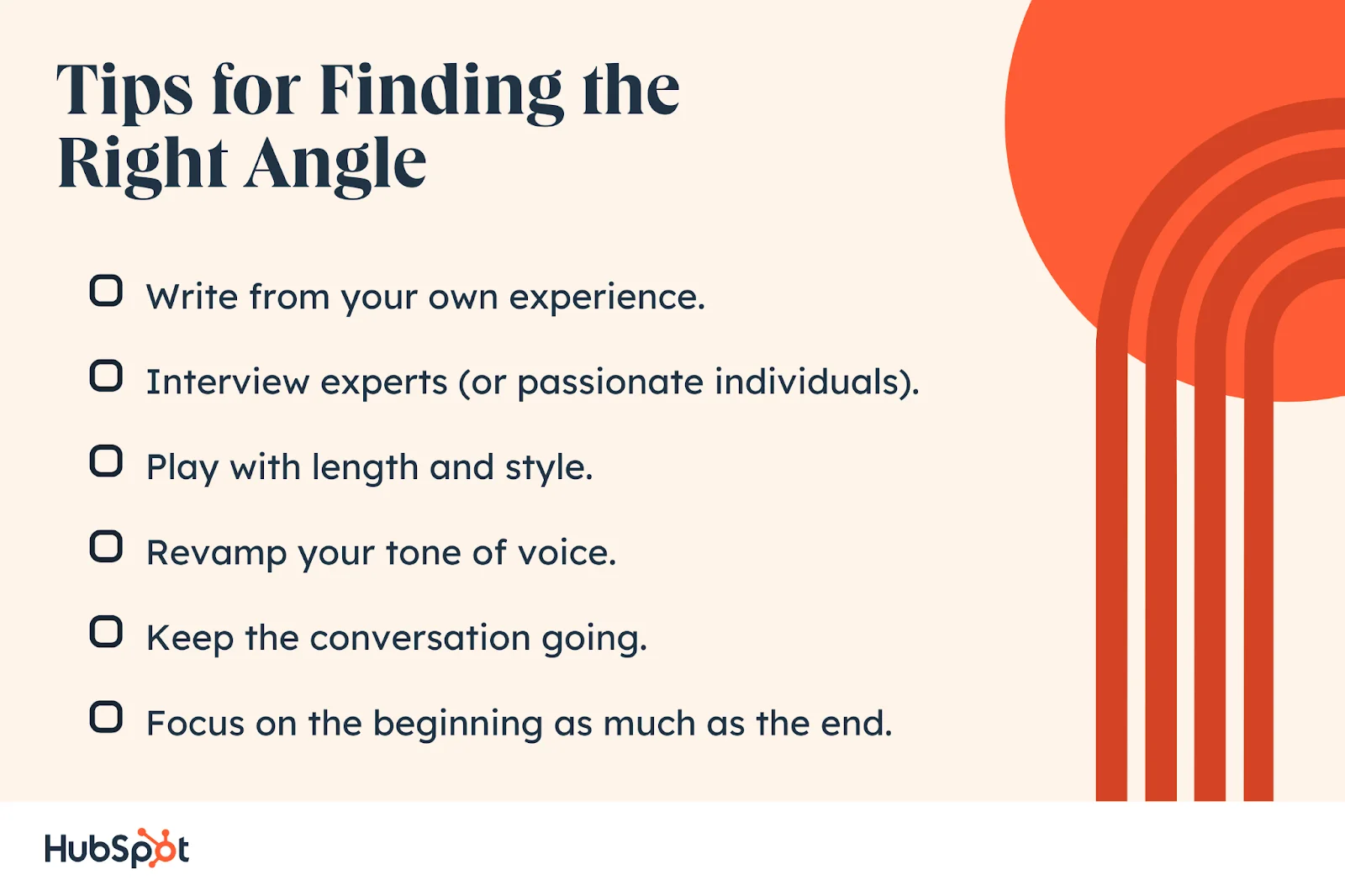Whether you are an author of novels, poems, journalism, or blogs, you’ve likely at some point experienced a much-dreaded rut. Nothing takes a hit at inspiration quite so hard. The standstills usually stem from a recurring pattern in your writing that leads to boredom and inability to reignite your “spark.”

I first started writing for the HubSpot Service Blog in 2018. As someone new to writing professionally at the time, I was incredibly excited to set my passion to the test, creating technical, informative blog posts. Of course, after a few months of inspired pen to paper, I began to lose some steam and struggle to define my voice.
What set me apart from the other blog writers? What could make my posts valuable in the crowded marketplace of articles, blogs, and YouTube videos explaining similar concepts?
That is when I discovered the importance of an angle. Below, I’ll dive into how content angles transformed my writing and how you can recreate the same magic.
What’s an angle?
An angle is a distinct way to look at a topic or argument to provide a fresh perspective. When I’m trying to build a convincing argument or story, I always consider my angle. And that’s made all the difference — from negotiating a higher salary at a new job to persuading my friends to try that new, albeit expensive, sushi restaurant in the West Village.
It feels second nature to consider angles verbally, so why not make it second nature to do the same in our writing?
Angle vs. Topic
So, the angle is how you approach a certain narrative. What makes that different from topics? An angle and topic are both essential to any writing piece, regardless of length or genre.
The topic is the what, as in, “What am I writing about?” or the overarching theme or question you’ve chosen or been assigned to write. The angle is the how, as in, “How will I write about this?” or how you can give your topic a personal touch and motive.
For example, let’s say I’m writing a piece about cartoons (I do work for Nickelodeon, after all). The topic would be what the story’s about — which cartoons I liked as a kid. The angle would be the substance of my argument. Perhaps I’m focusing on how these cartoons that I loved influenced the industry today.
.png)
6 Free Blog Post Templates
Save time creating blog posts with these free templates.
- "How-to" Post
- "What is" Post
- Listicle Post
- And More!
Importance of Having an Angle in Your Article
The mistake I believe many writers make is underestimating the importance of an angle in their writing versus just having a solid topic. You could have the best story in the world, but if you don’t shape how you want to tell that story, it can risk falling flat.
For example, I recently read the novel They Both Die at the End by Adam Silvera. This in itself is an interesting angle to take: revealing the conclusion of a book in its title.
Whereas other novelists might prefer the suspense leading up to a shocking conclusion, others might elect to state the conclusion up front and then build out a story that leads up to it. Same plots, yet different portrayals.
When it comes to blogs, it’s not enough to have an intriguing question or content piece to dive into. As I’m sure we’re all aware, the Internet is a vast place. I often feel like there’s nothing — no answer to a question, no revelatory idea — that doesn’t seem to already exist online. So, perhaps your topic isn’t the first of its kind out there.
Even if that’s the case, you hold a superpower — you can still provide a fresh angle. You can take a concept, spin it on its head, and write about it from a POV that can make readers consider your theory in a way they haven’t before. And that is the beauty of having a unique angle.
Tips for Finding the Right Angle

1. Write from your own experience.
A generic blog post is occasionally useful (i.e., hurriedly pulling up a recipe for exactly how long it takes to achieve the perfect softboiled egg). However, in most cases, a blog post is elevated when it has some of you in it.
You don’t need to be a creative writer to include some “I” statements and references to personal experience in your posts to set them apart from the crowd.
For example, if I were writing about the best project management tools, it would be much easier to pull from my experience and discuss how intuitive, organized, and painless Airtable has been for me across varying projects at multiple jobs. It’s much easier to get those first few words typed — which I often find to be the hardest part — when they are true to you.
Plus, there are benefits in search. Google is now optimizing for expertise, which means showcasing your lived experiences (especially with I statements) goes a long way. You’ll show that you’re trustworthy and an authority on a given subject matter.
2. Interview experts (or passionate individuals).
You may not always have a quick anecdote to pull up for every blog post. If you’re wracking your brains for how to still add a personal element to your post, you could consider interviewing someone who does have an experience worth sharing.
This person could be a field expert or a trusted acquaintance who can speak honestly and passionately about the topic. In college, I once wrote a blog post about thrifting versus fast fashion. While I already had a lot to say on the subject, it turns out a bunch of college kids with low budgets yet strong moral fiber had even more to add.
Not only do interviews incorporate a fresh perspective into your post, but you can even publish the post in a Q&A style for a break from the typical format.
3. Play with length and style.
Along with a Q&A discussion, there are many ways to change up the angle of your post — just by changing the way you write it.
If you’re typically known for lengthy blog posts, try shortening your next post. Rather than going in-depth about your argument or opinion, you can declare it short and sweet with a few supporting statements. Or if your posts are usually text-heavy, add some photos, videos, or audio clips.
As a marketer who often presents briefs and decks, I’ve found that no matter how compelling and illuminating my words may be, they are always better received when accompanied by graphics. Instead of merely using words to get your point across, you can always integrate audiovisual cues that provide proof and tap into different learning styles.
4. Revamp your tone of voice.
When writers infuse quips and humorous asides into an otherwise informative post, I find myself more engaged. I get a window into who they are, which makes me trust their expertise even more.
You can reframe how readers absorb your content by playing with the flavor of your piece. Try adding humor or personal interjections to cut through the dryness. When writing on a complex topic, you can angle your piece as metaphorical, weaving in analogies to help break down the concept.
If you typically dive into a post making your opinion loud and clear, you could practice playing devil’s advocate to help the reader consider both sides and come to their own conclusion. And if you already have one or more of these tricks up your sleeve, maybe keep your next piece concise and direct.
.png)
6 Free Blog Post Templates
Save time creating blog posts with these free templates.
- "How-to" Post
- "What is" Post
- Listicle Post
- And More!
5. Keep the conversation going.
As a marketer, I love when my audience wants to learn more and check out the other resources I’ve made. That’s why, in most of my blog posts (such as this one), I tend to link to other helpful resources to encourage readers to delve deeper and answer any lingering questions.
Leave your readers with links to blog posts, websites, research, and more that they can reference. In this way, you would be angling your piece as a continuation of a larger conversation and a shareout to similar or deeper resources that encourage the reader to take their learning into their own hands.
6. Focus on the beginning as much as the end.
It’s normal to want to build your post to a grand finale that leaves readers both more informed and yearning for more. However, how you kick off your post is just as important as how it ends - if not more important.
Using a blog post template can help you change up your go-to intro strategy and attempt something fresh that is sure to pull you out of a rut and inspire a new angle.
Angles Keep Your Content Fresh
We are all writers foremost, but we’re readers, too. Whenever I write a new blog post, I like to think about my audience’s perspective and consider, “Would I read this entire post? Would I enjoy it?”
It may take an eye-catching topic or title to draw people in initially, but an intriguing, impactful angle keeps them there until the end. Your angle makes your writing genuine, thoughtful, and unique to you. Otherwise, anyone could write it.
So, continue to test out new angles and challenge yourself to keep your content fresh and true to you.
Editor's note: This post was originally published in December 2011 and has been updated for comprehensiveness.




![How Often Should You (or Your Company) Blog? [New Data]](https://blog.hubspot.com/hubfs/how%20often%20should%20you%20blog%20%28external%20research%29_featured.png)
![19 Types of Blogs that Make Money in 2024 [+Examples]](https://blog.hubspot.com/hubfs/blogs-Jan-05-2024-05-12-25-3281-PM.png)
![The Top 3 Reasons Consumers Read Blogs & How to Attract Them in 2024 [New Data]](https://blog.hubspot.com/hubfs/202_Reasons-Consumers-Read-Blogs.png)




